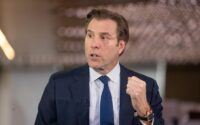Dollar dips as producer prices cool, euro hits one-year high
NEW YORK, April 13 (Reuters) – The dollar fell to a two-month low against a basket of currencies and a one-year low against the euro on Thursday after U.S. producer prices unexpectedly fell in March, boosting expectations that the Federal Reserve is near the end of its rate hiking cycle.
The producer price index (PPI) for final demand dropped 0.5% last month. In the 12 months through March, the PPI increased 2.7%. That was the smallest year-on-year rise since January 2021 and followed a 4.9% advance in February.
It comes after consumer price index (CPI) inflation data on Wednesday came in at 5% year-on-year in March, down from 6% in February. Core inflation – which strips out volatile food and energy prices – picked up to 5.6%, from 5.5% the previous month.
“We are headed back to a low inflation world, that’s the message of the market right now,” said Adam Button, chief currency analyst at ForexLive in Toronto. “The next big trade is that the inflation scare is over.”
Fed funds futures traders are pricing for the Fed’s benchmark rate to peak at 5.01% in June, from 4.830% now, before falling back to 4.34% in December.
The next major U.S. economic release will be retail sales on Friday, which will be analyzed for how inflation is affecting consumer spending.
Other data on Thursday showed that the number of Americans filing new claims for unemployment benefits increased more than expected last week, a further sign that labor market conditions were loosening up as higher borrowing costs dampen demand in the economy.
The dollar index fell to 100.84, the lowest since Feb. 2. The euro reached $1.10680, the highest since April 1, 2022.
The single currency is being boosted by a relatively more hawkish European Central Bank that is expected to keep raising rates to tackle inflation.
“We have seen a dramatic swing in interest differentials in favour of the euro,” said Ben Laidler, global markets strategist at eToro.
“The combination of falling U.S. inflation and rising recession risks have driven expectations of three Fed interest rate cuts this year compared to further hikes from the still-hawkish ECB.”
The ECB needs to keep raising rates given stubbornly high underlying inflation and its next move could be either a 25 or a 50 basis point increase, Governing Council member Bostjan Vasle said on Thursday.
ECB policymaker Joachim Nagel also said that core inflation rates in the euro zone will begin improving in the coming months, but the ECB still has a way to go with monetary policy.
The dollar fell 0.32% against the yen to 132.77 . The Aussie dollar , which is sensitive to risk appetite, reached $0.67965, up around 1.4% on the day and the highest since Feb. 24.
Australian employment blew past expectations for a second month in March while the jobless rate held near 50-year lows, an unambiguously strong report that suggests the central bank’s tightening campaign may not be over yet.
========================================================
Currency bid prices at 3:00PM (1900 GMT)
Reporting by Karen Brettell; Editing by Angus MacSwan
Our Standards: The Thomson Reuters Trust Principles.
[ad_2]
Source link


